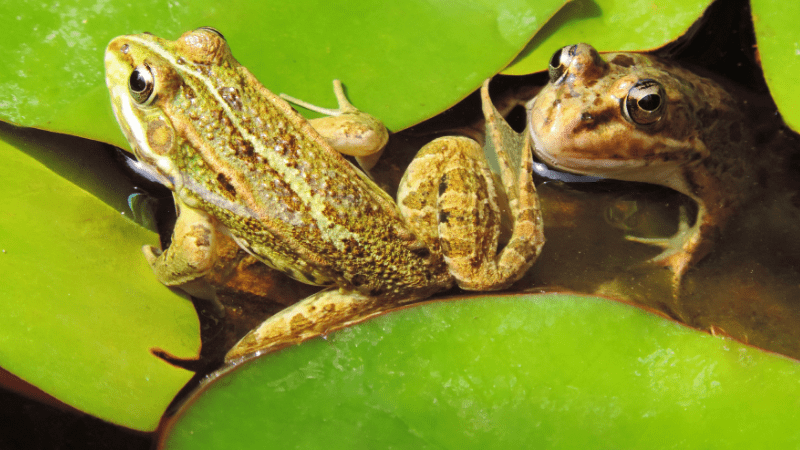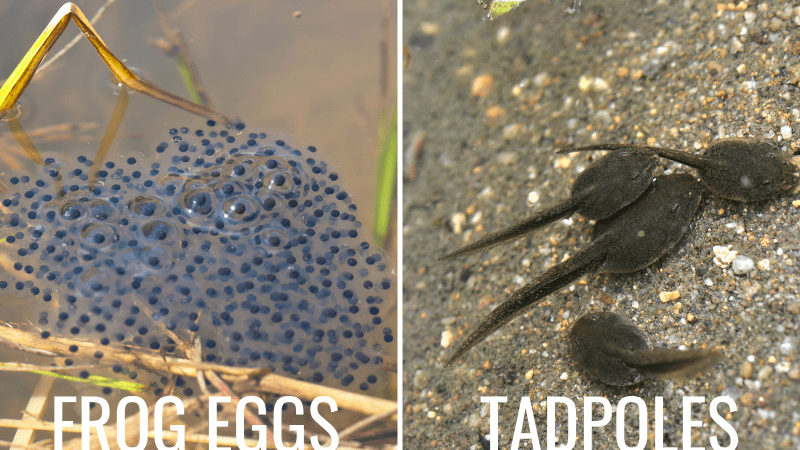How To Get Rid Of Frogs In A Fish Pond (Best Methods)
Whether you’re struggling with a frog infestation, predatory frogs, or noise issues, frogs can oftentimes be a real nuisance.
And while they can play a beneficial part in your pond’s ecosystem, sometimes they just got to go!
So, let’s learn how to get rid of frogs in a fish pond safely and naturally.
Plus, learn what attracted them in the first place so you can keep them from coming back.
Why Are There Frogs In My Fish Pond?

Frogs enjoy our fish ponds for many reasons. Like any of us, frogs need food, shelter, and water to survive, and our backyard fish ponds tend to provide all three!
Fish ponds tend to have clean, healthy water ideal for frogs to drink and lay eggs. Depending on your ornamentation choice, ponds can also provide shelter in the form of rocks, weeds, decoration, or tall grass. These environments can be perfect for tadpoles to grow and thrive, protected under algae or plants.
As a food source, ponds tend to attract mosquitoes and other water bugs that frogs eat. Some frogs are even known to eat smaller fish.
Overall, unless you take proper precautions, you might be creating a perfect home for local frogs in your fish pond.
Get Our Best Pond Tips Sent to Your Inbox for Free!
Join thousands of others and learn from our decades of pond building and maintenance experience! Your pond will thank you!
By subscribing you agree to receive emails from PondAcademy.com. We will always respect your privacy and you can unsubscribe at any time.
Is It Good To Have Frogs In Your Pond?
In general, frogs (and toads) can be a necessary and beneficial part of any ecosystem and do a lot to help control the bug population. However, having frogs in your yard can have some severe drawbacks.
One of the most common complaints about these amphibians is the noise. Frogs can create quite a disturbance croaking all night long, to the point that many people find it disrupts their sleep.
Additionally, certain frog species are invasive and harm your garden’s ecosystem by eating native frogs or other creatures. Native frogs in a small number may be beneficial to your habitat. Do your research so you can recognize an invasive species and humanely get rid of it.
Frogs can eat anything that fits into their mouths. If you have only small frogs, you shouldn’t have to worry, but larger frogs might be preying on your fish. Bullfrogs, in particular, can eat relatively large fish and are extremely loud.
How To Get Rid Of Frogs In Your Fish Pond
So, you’ve decided you need to get rid of some or all of the frogs in your fish pond – how do you do it without killing them? Here are a few of the best methods for removing frogs and keeping them from coming back.
Create Deterrents
You can do a few things to create an environment that is less welcoming or ideal for frogs to thrive. Try these methods:
- Install a waterfall or running fountain and remove any still or standing water from your yard. Running water features keep the water moving, and frogs prefer to lay eggs in still water. Additionally, mosquitoes thrive in standing water and are a food source for frogs. Check out our post on how to get rid of mosquito larvae in ponds for more mosquito control tips.
- Use vinegar, salt, or coffee grounds as a natural frog repellent. These substances irritate frogs’ skin, which may help deter them from your pond. Be careful when distributing, as vinegar or salt can damage plants, and coffee grounds can be acidic. Start by spreading either one of these around the perimeter of your pond. If any gets in your pond be sure to check your pond's PH to make sure it is still in an acceptable range.
- Install silt fencing or any kind of fence with tiny holes that frogs can’t jump through. You need to ensure the fencing is at least two feet high and at least one foot deep into the ground. For many of us, fencing is the last resort since it’s not aesthetically pleasing.
Remove Shelters
Frogs prefer to live in a sheltered place where they don't expose themselves to predators. They also look for protected areas to lay eggs and for their tadpoles to grow.
Remove anything near your fish pond that could cover frogs and tadpoles, including tall grass, weeds, etc. Algae also provide shelter for tadpoles, so keep your pond clean.
Remove Food Sources
Without even realizing it, we often provide a lot of food sources for frogs in our yards. To reduce food sources, consider removing the following:
- Outdoor lighting:Be sure to turn off any outdoor lighting at night. Lights attract bugs, which in turn attract frogs.
- Pet food: Don’t leave pet food outside overnight. Frogs have been known to eat pet food.
- Fallen food or fruit: Food attracts flies and other insects, which attract frogs. Remove any fallen fruits from your outdoor plants and be sure to keep your yard clear of any leftover crumbs or food.
Remove The Frogs
Now that your pond is no longer an attractive hangout for frogs, it’s time to get rid of any frogs you currently have. It’s reasonably simple to gently remove frogs and release them to a new home in the wild.
Using a net, gently scoop frogs out of your pond, or catch them on the ground. Drop them into a relatively deep container with a lid and air holes. You may need another person with you who can quickly open and close the lid before the frogs can jump out.
Once the frogs are all caught, you can bring them somewhere to release them safely. I recommend a local public park with a lake or pond.
You also need to check your fish pond for eggs or tadpoles.

These can be removed to another location easily with a bucket or net.
Why You Shouldn’t Kill Frogs
As we’ve mentioned, frogs can help create a balanced ecosystem and control the bug population. As long as the native population is not growing too large, you may be fine to keep your frogs and avoid killing natural wildlife.
More importantly, some frog species are endangered and are protected by law. Do your research so that you know which species your state has protected.
![]() Did you know...
Did you know...
The last Saturday of every April is Save the Frogs Day! It’s a world-wide event that was started in 2009. For more information, visit SaveTheFrogs.com.




